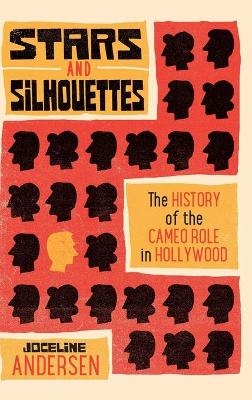
Stars and Silhouettes
The History of the Cameo Role in Hollywood
Seiten
2020
Wayne State University Press (Verlag)
978-0-8143-4690-7 (ISBN)
Wayne State University Press (Verlag)
978-0-8143-4690-7 (ISBN)
Traces the history of the cameo as it emerged in twentieth-century cinema. Although the cameo has existed in film culture for over a century, Joceline Andersen explains that this role cannot be strictly defined because it exists as a constellation of interactions between duration and recognition, dependent on who is watching and when.
Stars and Silhouettes traces the history of the cameo as it emerged in twentieth-century cinema. Although the cameo has existed in film culture for over a century, Joceline Andersen explains that this role cannot be strictly defined because it exists as a constellation of interactions between duration and recognition, dependent on who is watching and when. Even audiences of the twenty-first century who are inundated by the lives of movie stars and habituated to images of their personal friends on screens continue to find cameos surprising and engaging.
Cameos reveal the links between our obsession with celebrity and our desire to participate in the powerful cultural industries within contemporary society. Chapter 1 begins with the cameo's precedents in visual culture and the portrait in particular-from the Vitagraph executives in the 1910s to the emergence of actors as movie stars shortly after. Chapter 2 explores the fan-centric desire for behind-the-scenes visions of Hollywood that accounted for the success of cameo-laden, Hollywood-set films that autocratic studios used to make their glamorous line-up of stars as visible as possible. Chapter 3 traces the development of the cameo in comedy, where cameos began to show not only glimpses of celebrities at their best but also of celebrities at their worst. Chapter 4 examines how the television guest spot became an important way for stars and studios to market both their films and stars from other media in trades that reflected an increasingly integrated mediascape. In Chapter 5, Andersen examines auteur cameos and the cameo as a sign of authorship.
Director cameos reaffirm the fan's interest in the film not just as a stage for actors but as a forum for the visibility of the director. Cameos create a participatory space for viewers, where recognizing those singled out among extras and small roles allows fans to demonstrate their knowledge.
Stars and Silhouettes belongs on the shelf of every scholar, student, and reader interested in film history and star studies.
Stars and Silhouettes traces the history of the cameo as it emerged in twentieth-century cinema. Although the cameo has existed in film culture for over a century, Joceline Andersen explains that this role cannot be strictly defined because it exists as a constellation of interactions between duration and recognition, dependent on who is watching and when. Even audiences of the twenty-first century who are inundated by the lives of movie stars and habituated to images of their personal friends on screens continue to find cameos surprising and engaging.
Cameos reveal the links between our obsession with celebrity and our desire to participate in the powerful cultural industries within contemporary society. Chapter 1 begins with the cameo's precedents in visual culture and the portrait in particular-from the Vitagraph executives in the 1910s to the emergence of actors as movie stars shortly after. Chapter 2 explores the fan-centric desire for behind-the-scenes visions of Hollywood that accounted for the success of cameo-laden, Hollywood-set films that autocratic studios used to make their glamorous line-up of stars as visible as possible. Chapter 3 traces the development of the cameo in comedy, where cameos began to show not only glimpses of celebrities at their best but also of celebrities at their worst. Chapter 4 examines how the television guest spot became an important way for stars and studios to market both their films and stars from other media in trades that reflected an increasingly integrated mediascape. In Chapter 5, Andersen examines auteur cameos and the cameo as a sign of authorship.
Director cameos reaffirm the fan's interest in the film not just as a stage for actors but as a forum for the visibility of the director. Cameos create a participatory space for viewers, where recognizing those singled out among extras and small roles allows fans to demonstrate their knowledge.
Stars and Silhouettes belongs on the shelf of every scholar, student, and reader interested in film history and star studies.
Joceline Andersen is an Assistant Teaching Professor in Communication and English at Thompson Rivers University. Her research focuses on audience reception, community building through moving images, and popular cinema.
| Erscheinungsdatum | 11.09.2020 |
|---|---|
| Reihe/Serie | Contemporary Approaches to Film and Media Series |
| Zusatzinfo | 47 black & white images |
| Verlagsort | Detroit, MI |
| Sprache | englisch |
| Themenwelt | Kunst / Musik / Theater ► Film / TV |
| Sozialwissenschaften ► Kommunikation / Medien ► Medienwissenschaft | |
| ISBN-10 | 0-8143-4690-1 / 0814346901 |
| ISBN-13 | 978-0-8143-4690-7 / 9780814346907 |
| Zustand | Neuware |
| Haben Sie eine Frage zum Produkt? |
Mehr entdecken
aus dem Bereich
aus dem Bereich
wie KI und virtuelle Welten von uns Besitz ergreifen – und die …
Buch | Hardcover (2023)
Heyne (Verlag)
22,00 €
eine jüdische Filmgeschichte der Bundesrepublik
Buch | Hardcover (2023)
Hanser (Verlag)
28,00 €


